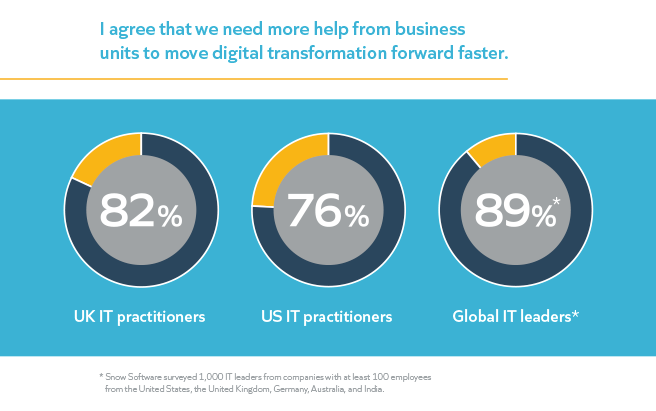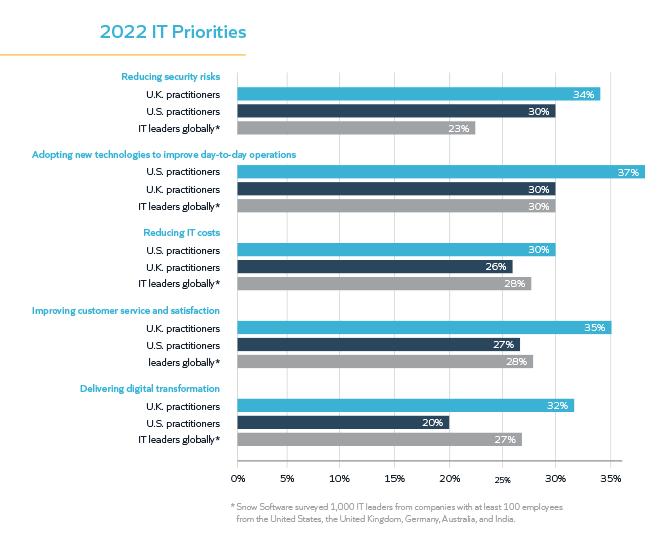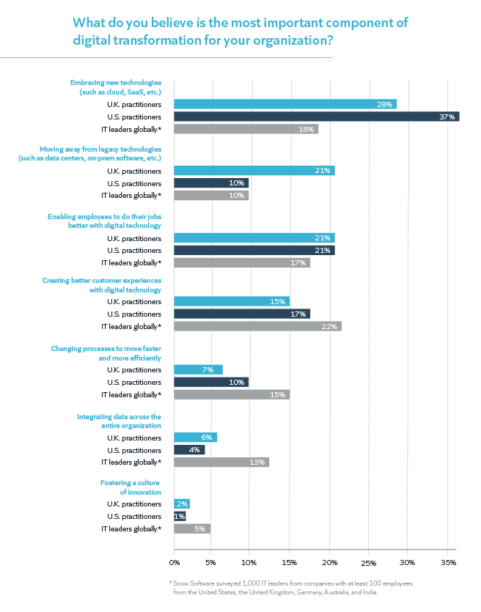2022 IT Priorities Report: Practitioners Need More Time To Innovate

In December 2021, we released the 2022 IT Priorities Report. In that report, we surveyed IT leaders around the world to document how their organizations changed in 2021 and to understand their priorities for 2022. As a follow-up, we surveyed 200 IT practitioners from the United States and United Kingdom to compare their responses to the December report. We found that 94% of U.K. and 89% of U.S. IT practitioners agree that innovation is one of their key objectives but creating a culture that supports innovation may be standing in their way.
Collaboration and Culture
The pandemic demonstrated the resilience and hard-earned abilities of IT professionals as organizations demanded support for remote/hybrid work, digital transformation and more. Approximately 8 in 10 of those surveyed in the U.K. (83%) believe that their company has become more innovative with their IT resources in the last year. This jumps to 92% for respondents in the U.S.
Prioritizing digital transformation was nearly ubiquitous among IT leaders and practitioners, with innovation closely following. However, the struggle to innovate is acutely felt at all levels, with IT practitioners (82% of U.K. and 76% of U.S.) and leaders (89% globally) indicating that they want more help from other business units to move digital transformation efforts forward faster.

Interestingly, less than 2% of IT practitioners surveyed (2% U.K. and 1% U.S.) believe that fostering a culture of innovation is an important component of the digital transformation initiatives at their organization. Only 5% of global IT leaders agreed that culture played a key role in digital transformation. Additionally, more than half of IT workers (70% of U.K. respondents and 53% in the U.S.) believe that their departments spend too much time reacting to problems and can’t be innovative. According to our 2022 IT Priorities Report, 71% of global IT leaders agree.
70% of U.K and 53% of U.S. respondents believe that IT spends too much time reacting to problems and can’t be innovative.
As organizations embark on the second half of the year, this is the time to assess if the team – and the company culture are serving the organization’s overall digital transformation goals. Constantly being in reactive mode and struggling to collaborate with business unit leaders are two huge challenges for IT. Now is the time for organizations to examine if their culture is supporting or hindering their digital transformation journey.
Priorities: Where Leaders and Practitioners Diverge
The IT leaders and practitioners we surveyed saw eye-to-eye on one priority last year: adopting new technologies to improve day-to-day operations.
For 2022, IT teams tend to be more focused on tactical priorities, such as mitigating security risks and continuing to deliver on digital transformation promises. Meanwhile, leadership is looking at ways to reduce overall spend as they simultaneously adopt new technologies and improve customer service and satisfaction. Security risks are high on the priority list for IT practitioners but are less important for leaders who are more focused on cost cutting.

Based on the responses above, the data suggests there’s a potential divide in the IT manager-employee relationship over which priorities are of importance. Could there be dissonance between IT leaders at the executive table and those on the front lines?
For example, reducing security risks was ranked as the number one IT priority in the U.K. over the last 12 months by IT practitioners (37%) and is top of mind for the coming year (34%). Investing in security tools was also ranked as the area with the greatest increase in spend by IT practitioners globally (80% U.K. and 71% U.S.) in the last year, as well as IT leaders (75%). When it comes to adopting emerging technologies such as IoT, AI, containers and more, IT staff (91% in the U.S. and 88% in the U.K.) feel very prepared in their own knowledge and skillsets to leverage these.
However, 88% U.K. and 87% U.S. practitioners surveyed agree that employee skillsets need to evolve to take advantage of emerging technologies. That said, 83% of those surveyed in the U.K. and 80% in the U.S. are confident their organization can ensure employees have the skills and training needed to adopt new technologies in the next year. Enabling employees to do their jobs better with digital technologies was ranked as one of the top three most important components of digital transformation for organizations, according to IT teams (21% in both the U.S. and U.K.).
To support the implementation of emerging technologies, IT practitioners would like to see budget increases for staffing across the department, with 65% of U.K. and 67% of U.S. respondents requesting a budget increase at the IT leadership level. More than two-thirds (71% U.K. and 66% U.S.) want more hiring at the practitioner level. This desired budget allocation aligns with IT leaders globally.

U.S. Organizations May Be Further Along on Digital Transformation
Unsurprisingly, adopting new technologies — and embracing those such as cloud and SaaS — are important priorities and components of digital transformation for IT teams. As such, many IT departments are seeing increased investments in related areas (SaaS, IaaS, PaaS, etc.) this year.
In the U.K., the surveyed IT teams claimed their companies made substantial increases in investments across SaaS, cloud infrastructure or IaaS, as well as cloud services/PaaS in the last year, and 74% would like to see a continued increase over 2022 — with 33% requesting a significant uptick in budget.
Globally, IT leaders were more aligned with the U.K. in terms of areas for spend in the last 12 months. After security tools, IaaS (73%), PaaS (71%) and SaaS (69%) followed. In the U.S., surveyed IT practitioners stated increases across a myriad of technologies, with SaaS, managed services and cloud services seeing the largest areas of increase after security tools. Thirty percent would like to significantly increase their overall IT services budget.
In the next year, IT practitioners expect to see greater investments made across AI, hybrid cloud, IoT and private cloud in their organizations, which aligns closely to IT leaders’ expectations. When asked to look five years out, they also believe that these same areas will see an increase in use within their organizations.
While companies on both sides of the Atlantic believe that moving away from legacy technology like data centers and on-premises software are an important component of digital transformation, there is continued investment in legacy technologies. However, these areas saw the greatest decrease in YoY spend, according to IT practitioners. Twenty-one percent of U.K. practitioners believe moving away from legacy technology like data centers and on-prem software is the most important component of digital transformation for their company, compared to only 10% of U.S. and 10% of IT leaders globally. This could indicate that U.S. companies are further along in their digital transformation journey than organizations in the U.K., and therefore assign less priority to moving away from legacy technology. While companies are still investing in technologies such as on-premises software and private cloud infrastructure, these areas saw the largest decrease in investment from U.K. organizations in the last 12 months, especially when compared to SaaS and cloud infrastructure and services.

IT departments have experienced huge challenges and change over the last few years. As we head into the second half of the year, IT leaders and staff have an opportunity to assess their barriers to innovation.
In the 2022 IT Priorities Report, 72% of IT leaders said they are unsure about how to get meaningful insights out of the wealth of data now at their fingertips, and 93% said IT must invest in tools and technologies to extract value from their data and turn it into actionable intelligence. We refer to this ability to gain a comprehensive view and understanding of all your technology assets as technology intelligence, and it is critical for innovation and growth.
We are halfway through the year. Do you have complete visibility and insight into your technology investments? Do you have a culture that supports your digital transformation and innovation goals? Are your team and leaders aligned on IT priorities?
If not, now is the time to reflect and adjust accordingly. Your innovation agenda could be at risk.